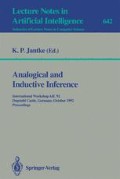Abstract
It has been recognized for some time that analogies can redescribe an object or situation sometimes resulting in a radically new point of view. While this creative aspect of analogy is often cited as a reason for its study, AI approaches to analogy have, for the most part, ignored this phenomenon and instead have focused on computing similarities between fixed descriptions. To study this ‘redescription’ process by which new points of view can be created, we seek a micro-world in which the redescription phenomenon occurs in its full subtlety but in which it can be isolated from extraneous and ill-understood factors. Proportional analogies (i.e., analogies of the form: A is to B as C is to D) in the abstract domain of geometric figures form just such a micro-world. In this paper, we describe an algebraic formulation of the redescription process in the context of geometric proportional analogies. We then discuss the design of a computer program called PAN which redescribes geometric figures while solving proportional analogy problems. Finally, we briefly discuss our plans for future work in this area.
Preview
Unable to display preview. Download preview PDF.
References
Chalmers D., French R., Hofstadter D., 1991, “High-Level Perception, Representation and Analogy: A Critique of Artificial Intelligence Methodology”, CRCC Technical Report 49 — March 1991, Center for Research on Concepts and Cognition, Indiana University, Bloomington, Indiana.
Dodge, C., 1972, Euclidean Geometry and Transformations, Addison-Wesley Publishing Company, Inc., Reading, Massachusetts.
Evans T.G., 1968, “A Program for the Solution of a Class of Geometric-Analogy Intelligence-Test Questions,” in M. Minsky (ed.) Semantic Information Processing, MIT Press, Cambridge, Mass. (1968), Chap. 5, pp. 271–353.
Falkenhainer B., Forbus K. and Gentner D., 1989, “The Structure-Mapping Engine: Algorithm and Examples,” Artificial Intelligence 41: 1–63.
Futrelle R., 1990, “Strategies for Diagram Understanding: Generalized Equivalence, Spatial/Object Pyramids and Animate Vision,” Proceedings of the 10th International Conference on Pattern Recognition, IEEE Computer Society Press.
Gentner D., 1983, “Structure-Mapping: A Theoretical Framework for Analogy”, Cognitive Science 7, pp. 155–170.
Greiner R., 1988, “Learning by Understanding Analogies,” pp 1–36, in Analogica, A. Prieditis (ed.), Morgan Kaufmann Publishers, Los Altos, California.
Hall R. P., 1989, “Computational Approaches to Analogical Reasoning: A Comparative Analysis”, Artificial Intelligence 39, pp. 39–120.
Hofstadter D.R., 1984, “The Copycat Project: An Experiment in Nondeterminism and Creative Analogies,” A.I. Memo 755, Artificial Intelligence Laboratory, MIT, Cambridge, Mass.
Hofstadter D.R., 1985, “Analogies and Roles in Human and Machine Thinking”, in Metamagical Themas: Questing for the Essence of Mind and Pattern, Basic Books, Inc., New York; Chap. 24 (pp. 547–603).
Hofstadter D. and Mitchell M., 1988a, “Concepts, Analogies and Creativity”, Proceedings of the Canadian Society for Computational Studies of Intelligence, Universtiy of Alberta, Edmonton, Alberta.
Hofstadter D.R. and Mitchell M., 1988b, “Conceptual Slippage and Analogy-Making: A Report on the Copycat Project,” Proceedings of the Tenth Annual Conference of the Cognitive Science Society, Lawrence Erlbaum Associates, Hillsdale, NJ.
Holland J., Holyoak K., Nisbett R., Thagard P., 1989, Induction: Processes of Inference, Learning, and Discovery, MIT Press, Cambridge, Massachusetts.
Holyoak K.J. and Thagard P., 1989, “Analogical Mapping by Constraint Satisfaction”, Cognitive Science, Vol. 13, pp 295–355, 1989.
Indurkhya B., 1989, “Modes of Analogy,” in K. P. Jantke (ed.) Analogical and Inductive Inference, Lecture Notes in Artificial Intelligence 397, Springer-Verlag (1989), Berlin, GDR, pp. 217–230.
Indurkhya B., 1991, “On the Role of Interpretive Analogy in Learning”, New Generation Computing, Vol. 8, No. 4, pp. 385–402.
Indurkhya B., 1992, Metaphor and Cognition: An Interactionist Approach, Kluwer Academic Publishers, Dordrecht, The Netherlands.
Kedar-Cabelli S., 1988, “Toward a Computational Model of Purpose-Directed Analogy,” pp 89–107, in Analogica, A. Prieditis (ed.), Morgan Kaufmann Publishers, Inc., Los Altos, California.
Korf, R. E., 1985, “Depth-first iterative deepening: An optimal admissible tree search”, Artificial Intelligence, 27(1):97–109.
Mitchell M., and Hofstadter D., 1990, “The Emergence of Understanding in a Computer Model of Concepts and Analogy-Making,” Physica D, 42:322–334.
O'Hara S., 1992, “Modelling the ‘Redescription’ Process in the Context of Proportional Analogies,” BU-CS Technical Report #92-002, Department of Computer Science, Boston University, Boston, Massachusetts.
Piaget J., 1947, The Psychology of Intelligence, translated by M. Piercy and D. Berlyne, reprinted by Littlefield, Adams & Co., Totowa, New Jersey, 1981, by permission of Humanities Press Inc., New York, New York.
Piaget J., 1953, Logic and Psychology, Manchester University Press, Manchester, UK.
Piaget J., 1970, Genetic Epistemology, translated by E. Duckworth, W. W. Norton and Company, New York, New York.
Rosch E., 1978, “Principles of Categorization,” in Cognition and Categorization, E. Rosch and B. Lloyd (eds.), Laurence Erlbaum Associates, Hillsdale, New Jersey, pp. 27–77.
Sterling L. and Shapiro E., 1986, The Art of Prolog: Advanced Programming Techniques, MIT Press, Cambridge, MA.
Smith E., 1989, “Concepts and Induction,” in Foundations of Cognitive Science, M. Posner (ed.), The MIT Press, Cambridge, Massachusetts.
Winston P., 1978, “Learning by Creating and Justifying Transfer Frames,” Artificial Intelligence, 10(2): 147–172.
Winston P., 1980, “Learning and Reasoning by Analogy,” Communications of the ACM 23(12): 689–703.
Author information
Authors and Affiliations
Editor information
Rights and permissions
Copyright information
© 1992 Springer-Verlag Berlin Heidelberg
About this paper
Cite this paper
O'Hara, S. (1992). A model of the ‘redescription’ process in the context of geometric proportional analogy problems. In: Jantke, K.P. (eds) Analogical and Inductive Inference. AII 1992. Lecture Notes in Computer Science, vol 642. Springer, Berlin, Heidelberg. https://doi.org/10.1007/3-540-56004-1_19
Download citation
DOI: https://doi.org/10.1007/3-540-56004-1_19
Published:
Publisher Name: Springer, Berlin, Heidelberg
Print ISBN: 978-3-540-56004-3
Online ISBN: 978-3-540-47339-8
eBook Packages: Springer Book Archive

